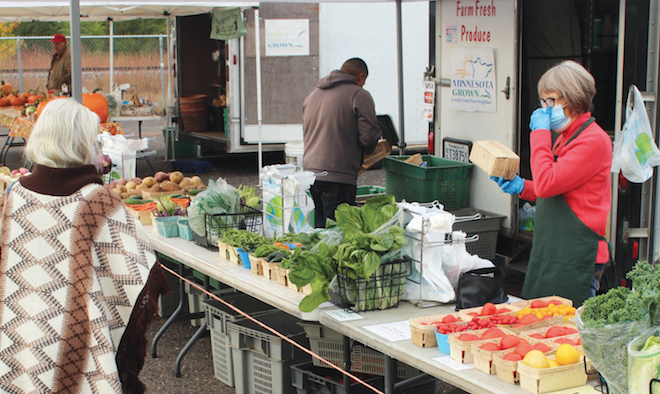
Feb 2, 2021Direct sales still key despite COVID-19 market changes
Direct sales at farmers’ markets and farm stands have been the only outlets for Thorson’s Farm Fresh Produce of Browerville, Minnesota, but the uncertainty of the pandemic meant developing a website for the 2020 season.
“We structured our online presence this year based on COVID. We wanted to have alternatives – depending on how the year went,” said Erik Thorson, the second generation member of Thorson’s with his wife, Sara.
But the farmers’ markets and farm stands adapted and customers kept coming.
Masks and gloves for workers, and hand-washing stations for customers, became standard. Space was added to keep a safer distance between workers and customers. Transactions were streamlined so customers could get in and out more quickly – and customers noticed.
“People saw it as a pretty safe environment,” Thorson said.
Thorson’s Farm Fresh Produce sells at four farmers’ markets and two farm stands in Minnesota. The farmers’ markets include the three Brainerd Lakes Area Farmers’ Markets in the towns of Nisswa, Baxter and Brainerd and at the St. Cloud Area Farmers’ Market in St. Cloud.
Thorson’s also sells at their farm market in Long Prairie and at a stand near Park Rapids where Erik and Sara live. Erik works for the state of Minnesota’s Department of Natural Resources and Erik and Sara are in the process of slowly taking over managing the farm from Erik’s parents, Mike and Eloise Thorson. Facebook updates on market day confirm to customers Thorson’s Farm Fresh Produce will be at the market and highlights what’s available. An email group works well, too – especially for regular customers.
Thorson’s started featuring half-bushels of vegetables in 2020 for canning, pickling or freezing and it was surprisingly successful. People had more interest in local growers because of COVID and had a lot more time on their hands. “We talked to a lot of people who were canning or pickling for the first time,” Thorson said. “There was a lot of interest and my mother gave a lot of advice.”
Pickling cucumbers, tomatoes, dill, Roma tomatoes, beets and green beans were all offered in half bushels in 2020.
“We grew more green beans and carrots this year,” Thorson said. “They’re more labor-intensive but have a stronger market. We do a lot of sweet corn and romaine lettuce and had a lot more varieties of head lettuce this year.” Slicing cucumbers, summer and winter squash, potatoes, onions, zucchini, cabbage, broccoli, cauliflower, kohlrabi, sweet and hot peppers, and melons and watermelons are also grown.
Thorson’s Farm Fresh Produce has three high tunnels, nine hoop houses and about 13 acres of vegetable production. They have seasonal employees for both selling and growing vegetables. “We do a number of plantings. We try to have a reliable supply throughout the season,” Thorson said.
The operation has a germination seed house and grows its own transplants. Transplants are started at the end of March because the season is so late in north central Minnesota. The transplants are moved from the germination seed house to a starter greenhouse before being planted in the hoop houses in early May. “We had hard frosts in the middle of May last year,” Thorson said. “We had to cover the plants and provide a little supplemental heat.”
Slicing cucumbers are grown inside on trellises. “It’s a good way to get cucumbers early in the season,” Thorson said, “and for later plantings.”
Pickling cucumbers are grown outside in barrels with drip irrigation going to each barrel. “The barrels work well,” Thorson said. “The cucumbers cascade over the barrels and we pick three times a week.” The cucumbers are easy to harvest because workers don’t have to get down on the ground to pick.
The year of 2020 was a rough one for vegetable growers in north central Minnesota. Besides the late, hard frosts in mid-May, there was an early frost in September. “We were able to save a lot,” Thorson said. “We picked a lot to get it inside or tried to cover it.”
It’s been an evolution for Thorson’s Farm Fresh Produce. At one time the farm raised soybeans and corn, and fed out dairy steers, and then transitioned to farrow to finish hogs – until hog prices plummeted. “Lots of traditional farms were struggling,” Thorson said, “and Dad saw the writing on the wall.” Broiler chickens with a state-inspected plant was the next enterprise. The Thorsons were at farmers’ markets selling whole fryer chickens and saw an advantage to selling vegetables at the markets, too. They converted their irrigated row crops into vegetables for direct sales and grew winter squash for the wholesale market. They eventually dropped the wholesale market and broiler enterprise to focus solely on fresh market vegetables.
“We evolved and adapted to stay in business and stay profitable,” Thorson said. “Our business model is to sell at farmers’ markets and at our own stands. Stick with your business model and try to keep it moving forward.”
— Dean Peterson, VGN correspondent
















